Crispy, tasty chicken pieces stir-fried with a generous amount of dried chillies and Sichuan pepper, Mala chicken is a classic delicacy not to be missed.
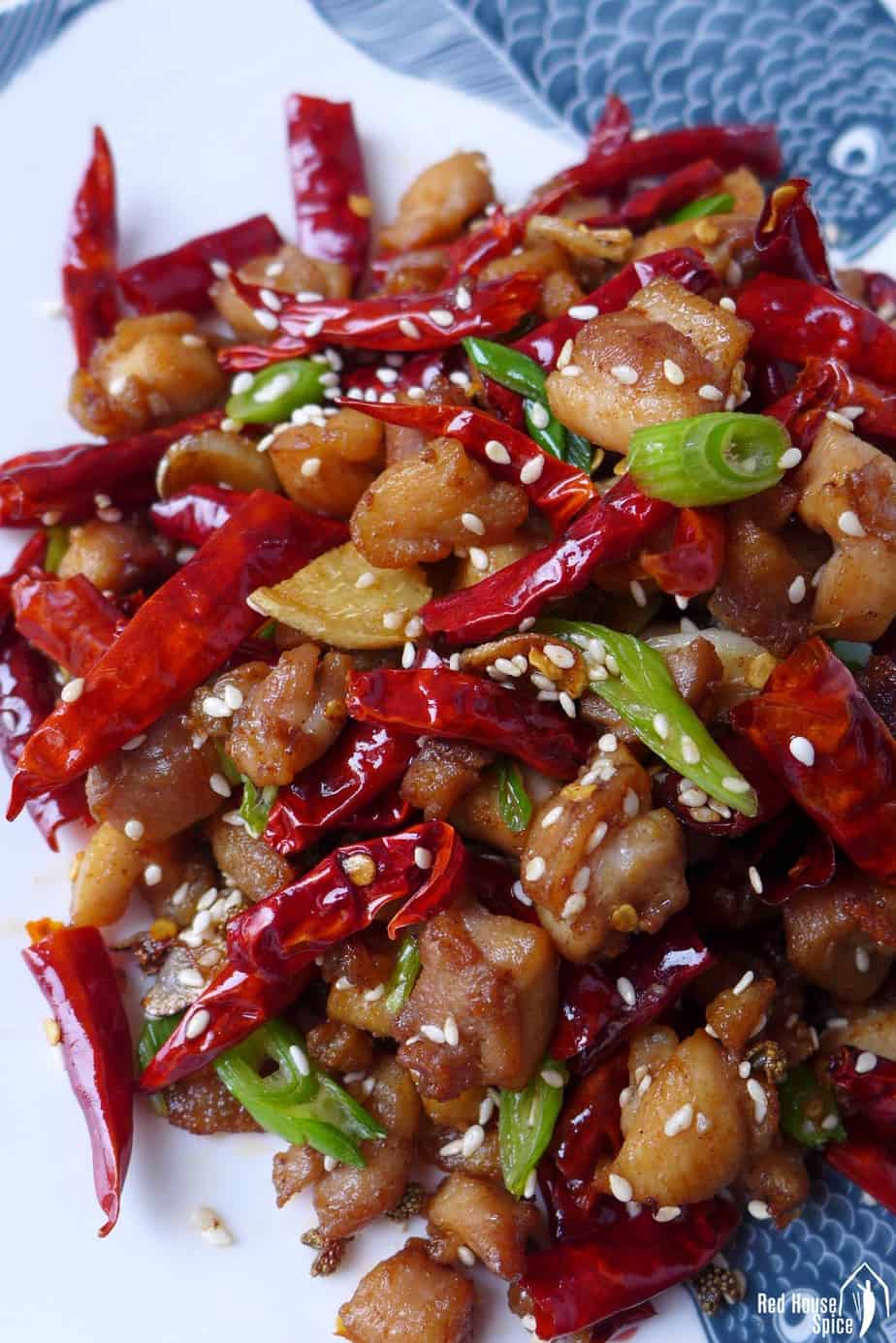
As you may have noticed, I’m a huge fan of Sichuan food. Today’s recipe Mala chicken (Chongqing Laziji, 辣子鸡) is another signature dish of this fascinating cuisine.
Originating from Chongqing city, Mala chicken is popular nationwide in China. Vibrant in colour and sharp in taste, it’s a classic delicacy not to be missed.
Many people think mala chicken is a fun dish to eat. In restaurant versions, small pieces of chicken are usually buried in large amounts of dried chillies. So sometimes you really need to make an effort to find the chicken. It’s like a treasure hunt! My homemade version has more balanced proportions. However, please feel free to increase the volume of chillies if you enjoy the hunt!
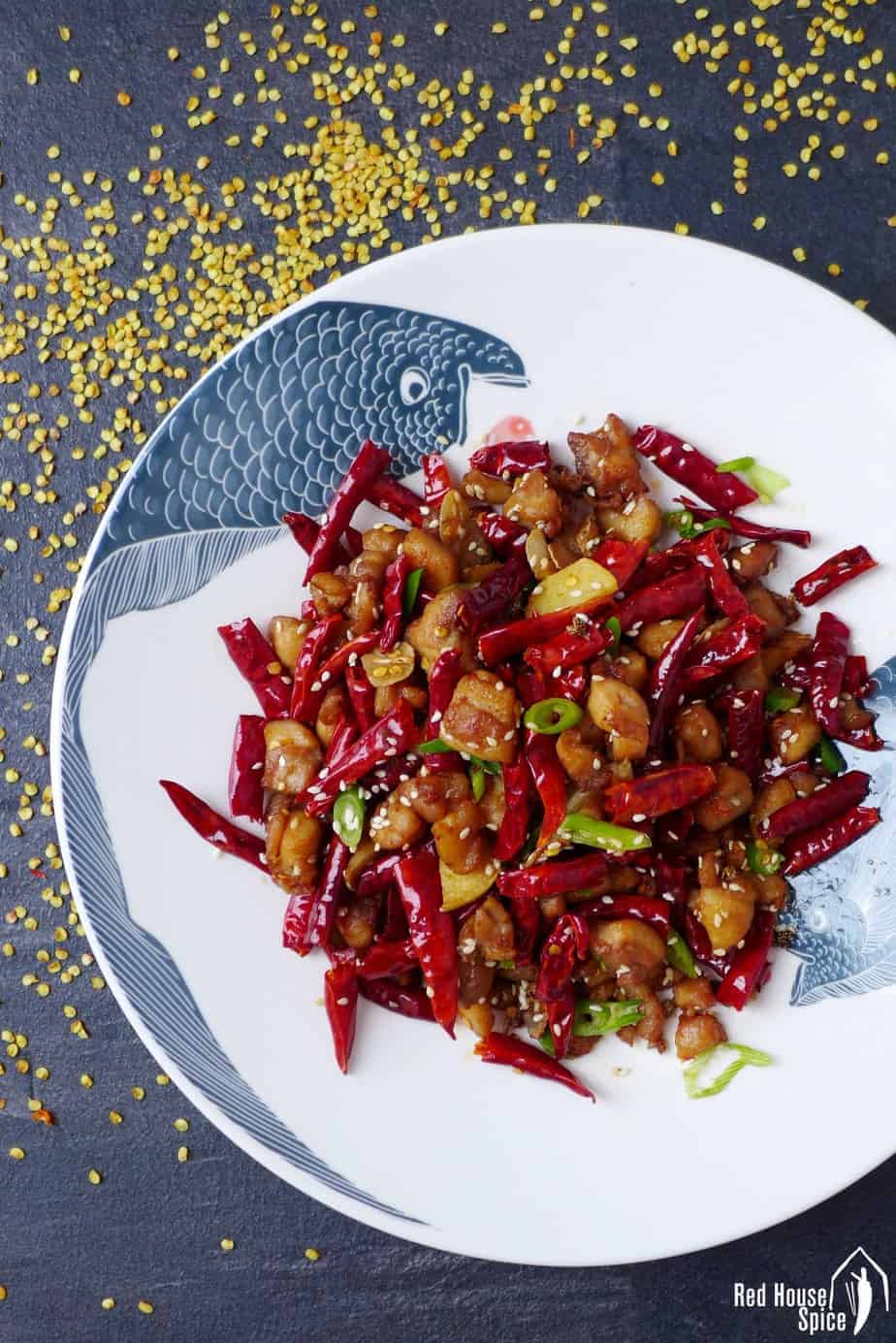
Marinate the chicken
A tasty plate of mala chicken shouldn’t be just hot. It needs to be aromatic too. The marinating process allows the chicken pieces to absorb all the flavours from the seasoning.
- You will need ginger, spring onion, light soy sauce, Shaoxing rice wine, white pepper and salt.
- 20 minutes is the minimum time for marinating.
- I often leave it in the fridge overnight for an even better taste.
- Before deep-frying, don’t forget to remove the ginger and spring onion.
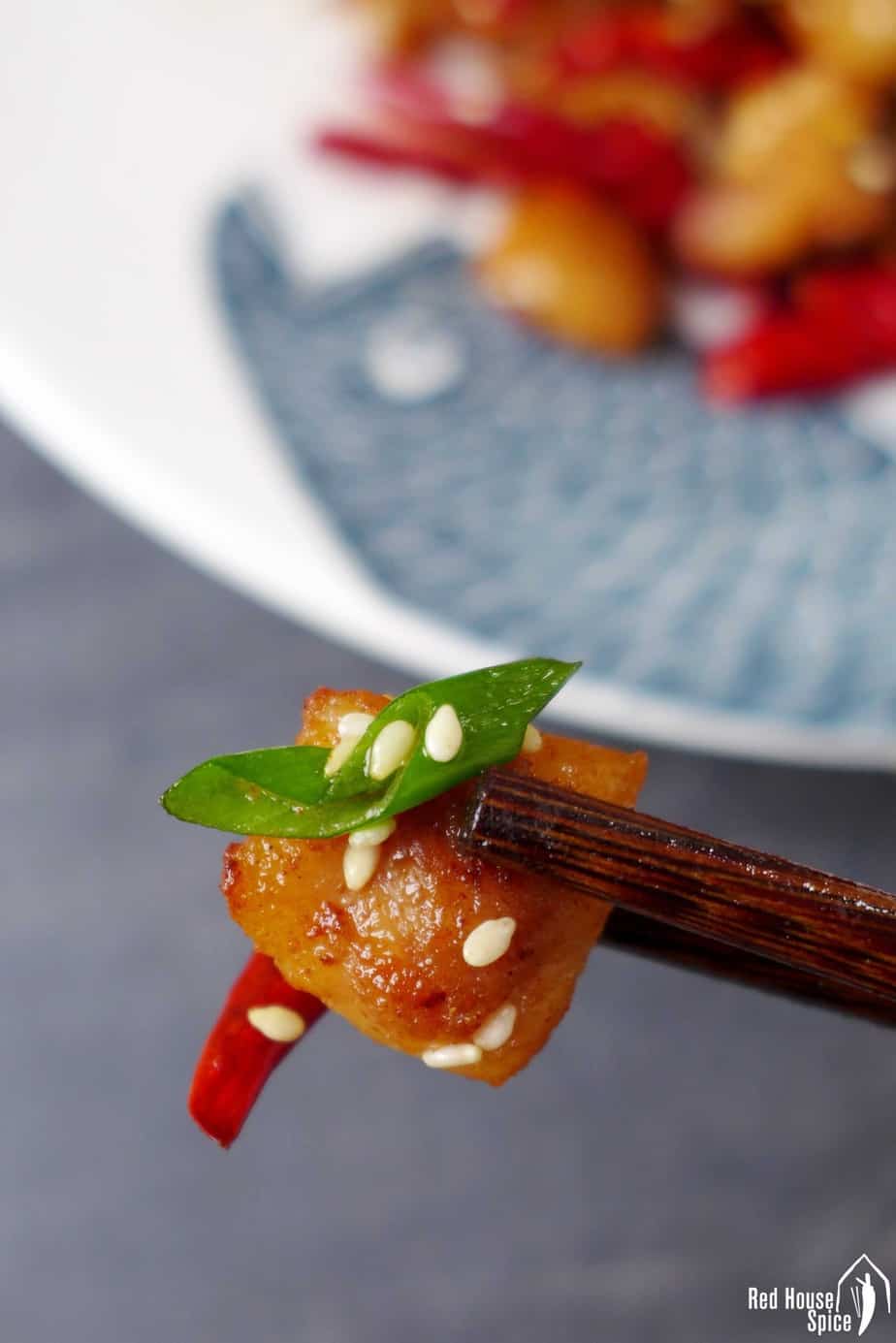
Deep fry twice
The marinated chicken pieces need to be deep-fried twice to achieve the desired texture and look. Temperature control is quite important during this process. It’s straightforward if you have a kitchen thermometer at hand. Otherwise, you need to watch attentively for the clues (Please refer to my video).
- The first time: Add chicken to the oil when it reaches 160°C / 320°F. You may put in one piece to test. You should see bubbles immediately appear around the chicken. Fry for about 3 minutes until the edges of the chicken turn lightly brown (adjustment may be necessary depending on the size of your chicken pieces).
- The second time: Wait for the temperature of the oil to rise to 180°C / 356°F. At this point, the surface of the oil should look very calm and you would see a little smoke appear. Once you add the chicken, the oil should bubble intensively. Fry for no more than 1 minute this time. The finished chicken should be evenly golden and crispy on the outside.
The mala flavour
Needless to say, the key flavour of this dish is “Mala (麻辣)”, namely hot and numbing. You will need quite a lot of dried chillies and Sichuan pepper to create this addictive taste.
Classic mala chicken calls for 3 types of dried chilli produced in Sichuan province, China. They have different levels of heat and aroma. For home-cooked version, please feel free to use any good quality, aromatic dried chillies that are available to you. If you think the dish might turn out to be too spicy (considering the quantity required), I suggest you remove the seeds from the dried chilli.
I like using green Sichuan pepper for this dish as they produce a more intense numbing effect than regular dark red Sichuan pepper. Try it if you can get hold of them.
The final stir fry
Finally, it’s the stir-frying process to combine the chicken with the spices. There is one thing that I’d like to stress: Use medium-low heat to slowly bring out the flavour of the spring onion, ginger, Sichuan pepper and dried chillies without burning them. Retain the same heat when adding the chicken and other seasonings. Right before you dish out, sprinkle sesame seeds and finely chopped spring onion.
More Sichuan dishes to try
If you find this mala chicken tempting, have a look at other classic Sichuan dishes on the blog:
- Mouth-watering chicken (Kou Shui Ji, 口水鸡)
- Sichuan boiled fish (Shui Zhu Yu, 水煮鱼)
- Hot Pot At Home (火锅)
- Twice-cooked pork, the fast version (回锅肉)
- Fish with Sour Vegetables (酸菜鱼)
- Mapo tofu, the authentic way (麻婆豆腐)
- Hot and sour glass noodle soup (酸辣粉)
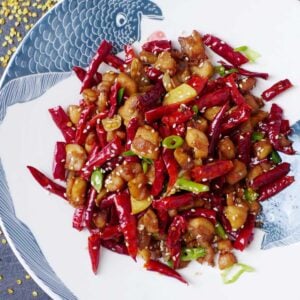
Mala chicken (Chongqing Laziji, 辣子鸡)
Ingredients
Group 1
- 400 g / 14oz chicken thigh - deboned with skin on (see note 1)
- 6 slices ginger
- 1 stalk spring onion - cut in sections
- 1 teaspoon light soy sauce
- 1 teaspoon Shaoxing rice wine
- ¼ teaspoon salt
- 1 pinch ground white pepper
Group 2
- 500 ml / 2 cups cooking oil - see note 2
Group 3
- 30 g / 1oz dried chillies - or to taste
- 1 teaspoon whole Sichuan peppercorn - see note 3
- 8 slices ginger
- 4 cloves garlic - sliced
- 1 teaspoon light soy sauce
- 1 pinch sugar
- 1 teaspoon Shaoxing rice wine
- 1 teaspoon toasted sesame seeds
- 1 stalk spring onion - finely chopped
Instructions
- Cut the chicken into bitesize cubes. Mix with all Group 1 ingredients. Marinate for 20 minutes (or longer if you wish). Remove ginger and spring onion before deep frying.
- While waiting, prepare the dried chilli. Break each one into half then remove the seeds (see note 4).
- Heat up oil over a high heat. When the temperature reaches 160°C / 320°F, gently slide in chicken pieces. Fry for 3 minutes or so (when the edges of the chicken lightly brown).
- Remove the chicken from the oil. Continue heating up the oil. Put the chicken back in when the oil reaches 180°C / 356°F. Fry for 1 minute then take out.
- Leave about 1 tablespoon of oil in the wok. Fry ginger, garlic and Sichuan pepper over a medium low heat for 1 minute. Add dried chillies. Retain the heat level and fry until fragrant (do not burn).
- Stir in chicken pieces. Add soy sauce, sugar and rice wine. Cook a further 2 minutes. Sprinkle sesame seeds and spring onion. Give everything a quick stir then dish out.
Video
NOTES
NUTRITION DISCLOSURE: Nutritional information on this website is provided as a courtesy to readers. It should be considered estimates. Please use your own brand nutritional values or your preferred nutrition calculator to double check against our estimates.

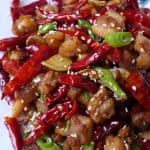
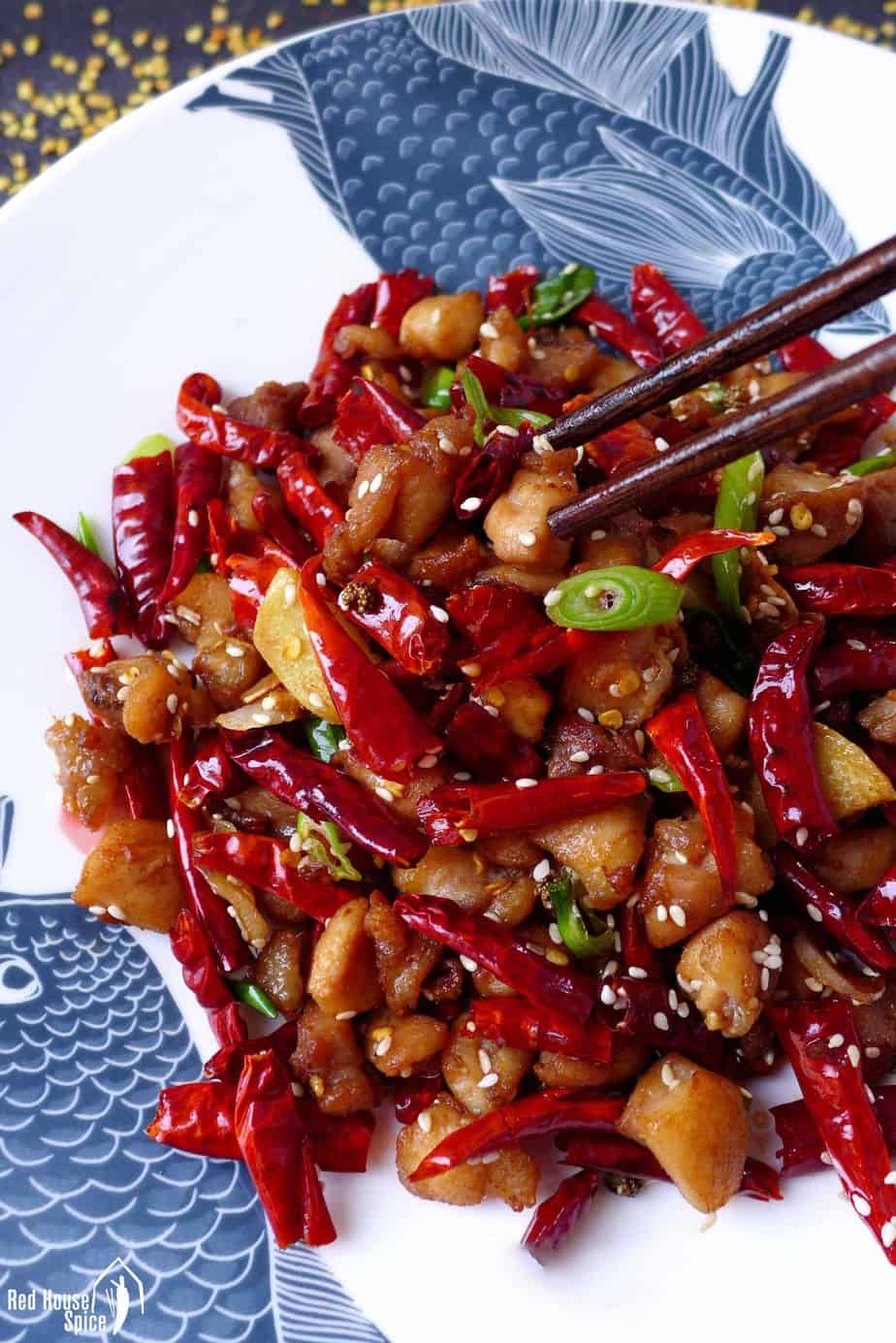




I. Like spicy food
Craving something spicy, I came across this recipe online and this spicy chicken recipe is easy to learn but tastes amazing! The freshness of the chicken blends perfectly with the spice of the chili peppers and the crunchy texture of the peanuts makes every bite a delight. Excellent with rice or beer. Highly recommended for those who love spicy flavors!
Thank you so much for the feedback. Glad you find my recipe helpful. BTW, I’ve deleted the link in your original comment as external links are not permitted in the comment section.